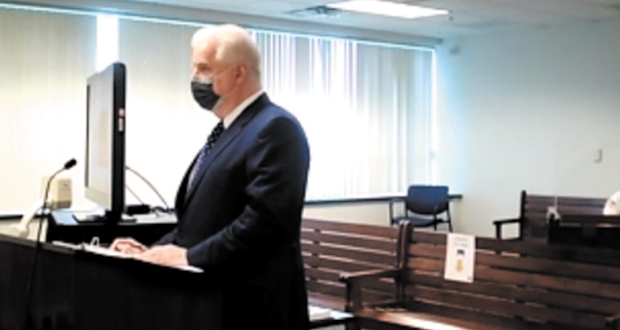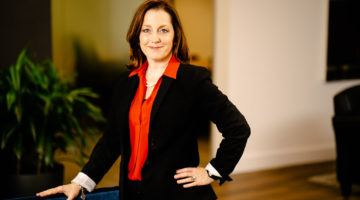“We have a verdict!”
The familiar cry from the court officer echoes through the empty hallways of the Middlesex Superior Court in Woburn as I sit alone trying to focus on accumulated emails. Scrambling to my feet, I join the others of this trial, who quickly gather in their designated spaces.
Shortly thereafter, the eight jurors, six designates, and two alternates who deliberate by agreement walk into Courtroom 540 from their jury deliberation room across the hall in Courtroom 520. They enter from the public entrance of the courtroom and proceed toward their respective socially distanced seats, single file, looking neither left nor right, each face equally impassive, poker-style, not betraying any hint of what is to come.
The jurors have deliberated four hours in this sixth day of trial, and it is now 3:50 p.m., beating by 10 minutes the deadline I had promised my client. The deliberation is a bit longer than comfortable for a defendant hoping for a quick verdict, so I, like others, remain in suspense.
All 20 or so in the courtroom wear masks, mostly black, grey, or the familiar powder blue, except our judge who favors a clear plastic forehead-to-chin headpiece.
“Jurors, please remain standing; all others may be seated,” rings out our court officer, again in authoritative tone. “Hearken to your verdict, Mr. Foreman. Have at least six of the eight of you reached a verdict?”
“Yes, we have.”
The verdict slip, consisting of answers to 24 special questions encompassing three different claims and three different counterclaims, is passed to our judge, who reads the verdict slip to himself for what seems like an eternity. Finally, the judge passes the slip to his clerk, stating, “You may record the verdict.”
The case
I’ve been retained by an old friend and colleague to try this nasty dispute between neighbors. The actionable facts begin in December 2016 and continue almost to the courthouse steps. The suit itself has been pending since October 2018.
Disputes between neighbors, unlike fine wines, do not grow better with age, so we are grateful for a courtroom and jury to hear this case in what seems like record time.
The plaintiffs are a husband and wife. My client is the local funeral home. They share a common property line. The initial dispute is about the functioning and ultimate failure of a drainage system owned and maintained by the funeral home, with resulting flooding to both properties.
This has escalated over time to include other points of contention, including a counterclaim under the so-called “Spite Fence Statute,” which permits damages and abatement where one neighbor has erected a fence that “unnecessarily exceeds six feet in height” and which is “maliciously erected or maintained for the purpose of annoying the owners or occupants” of the adjoining property.
The statute has been around for 130 years, long before Robert Frost’s aphorism that “good fences make good neighbors.” Despite over 40 years of practice, I had never heard of the law before this case.
Pre-trial
We pre-try this case three times, all by Zoom. We have a March 15 trial date, set as a result of a postponement from November.
The first is a screening conference about a month before trial. We are under the Supreme Judicial Court’s order for jury trials, and it is clear the court is looking for a relatively straightforward civil case that can be tried in one week on a 9 a.m. to 1 p.m. schedule.
The court is operating under a “one trial per courthouse” basis, so we will be the only case on trial. We pass this first test with a caution that we might be bumped depending on input from the regional administrative judge as to whether we simply have too many people for a comfortable COVID-era trial. Our number is eight: two plaintiffs and their two counsel, one defendant’s representative, two defense counsel, and referring counsel.
The second is the actual substantive conference 11 days before trial, so we evidently have passed the first hurdle. Both sides have filed proposed jury verdict questions, jury instructions, requests for voir dire, and three motions in limine (packaged under Superior Court Rule 9A).
The court hears the motions and efficiently allows all three, excluding any expert testimony from the plaintiffs and a couple of defense documents. We inform the court that one of our witnesses, an official in the local municipality, is in COVID quarantine. The court agrees to allow the witness to testify by Zoom. We also learn we will be the second jury trial in that courthouse since COVID.
The third occurs the Friday before trial to go over logistics of empanelment and witness issues. We inform the court that another of our witnesses, again from the town, now also is in quarantine, and it is agreed he may testify via Zoom as well. We assure the judge the case will not be settled. We are asked to be there by 8:30 a.m. Monday.
Both sides benefit from having cooperative counsel who have agreed upon virtually all exhibits and have split the cost of creating 10 exhibit binders, one for each juror, one for the court, and one for the witness.

Day 1: start of trial/empanelment/openings
I pull into the convenient no-charge parking garage at 8 a.m. I am a traditional trial lawyer, still somewhat untrusting of IT. I have a dozen boards suitable for easels — timelines, property histories, key plans and drawings, and photos of the properties. My one concession to the 21st century is a laser pointer.
I am first in line at the courthouse door and wait in the freezing cold for admittance. I have forgotten my bar card, a bad omen, and the officers must process all my files through an airport-like screening machine. At least I pass the temperature test.
I am the first in the courtroom, which is always my goal. I do not believe in superstition, but I am a superstitious person, so arriving first is important. I calmly unpack and set up before others arrive. This allows me also to assess where we stand for openings and closings and other courtroom geography issues.
I note one problem: Where we stand to examine witnesses is at a lectern outside the active courtroom space, in the front of the spectators’ gallery. It is about 50 feet from the witness. I have a loud voice so this is not an auditory issue, but I believe your effectiveness in communication increases as you get closer to your conversational partner, especially an adversary.
My concern about witness distance is confirmed. I feel like I am shouting across the street to get someone’s attention, and the plastic barrier at the witness stand seems more a shield against aggressive examination than a COVID precaution.
On the plus side, there is an “ELMO” with a zoom feature that is easy to use to broadcast exhibits onto various screens in the courtroom, including one next to the witness. Also helpful is the fact that the lectern for openings and closings is squarely in front, and at the center, of the jury.
We begin promptly, and all of us are soon heading down to the third floor where about 60 potential jurors are gathered. Although the parties have agreed on approximately 30 questions to be submitted to the panel, the judge has narrowed this to a more workable 17. The agreed description of the case has been boiled down to a bare minimum.
We finally receive our “Confidential Juror Questionnaires” and I see nothing has changed in the form used for decades. I madly read through each biography, listening with one ear to the court as I tentatively note one of three options on each form: yes, no, and question mark.
From the outset, our judge sets a tone with the potential jurors that they are critical to the process. He thanks them for their service in difficult times. He is clear about the schedule. Somewhat surprisingly, the 17 questions weed out few who might have an issue hearing the case.
We proceed back to Courtroom 540 with a reduced panel and quickly populate the eight seats. We have four peremptory challenges and each side uses three. Somewhat remarkably, few jurors try to avoid service due to scheduling issues.
The judge gives counsel the opportunity to question prospective jurors, and each side uses that right sparingly. We finish with a jury of four men and four women, from their early 30s to their early 60s. There are few millennials or boomers in our pool. We have a very good mix of sophisticated and intelligent people from different walks of life. The jurors are sworn.
It is now 11:50 a.m., and we are ready to go. The trial is televised through Zoom. This enables my out-of-state client representative to observe the trial. Even my younger daughter, a third-year student at Suffolk Law, is able to watch occasionally.
After the morning break, the court, without objection, gives a pre-charge outlining the prima facie elements of each claim and counterclaim sounding in nuisance, trespass, and negligence.
Opening statements follow. We have 20 minutes each, a slight expansion of the 15 minutes allowed by Superior Court Rule 7. I learn two things in this brief period. One, I can talk comfortably through a mask for some length of time. Two, I cannot do this wearing glasses, as they quickly fog, leaving me peering Magoo-like at my audience of eight.
I remove the glasses, abandoning my outline and concentrate instead on making eye contact with each juror, methodically working my way, beginning back row left to right, from juror one, finishing with juror five front row left, and then repeating the circuit until I run out of words.
It is now 12:55, and the court allows the jurors to leave a few minutes early, cautioning all to stay off the internet, to refrain from any personal investigation, and not to talk about the case to anyone, not even a spouse. It is a caution that is repeated at the end of each day with a check-up each morning to make sure the caution has been heeded.
The trial: days 2 through 5
I’m back the next morning, more lightly encumbered, and this time ready with my bar card. Unfortunately, it is last year’s now-expired card. It is another bad omen, but the security officer waves me through with a request I come tomorrow with a current bar card.
To my dismay, I am also the second to arrive in court that morning. My senior opposing counsel, and the only one in the courtroom older than I, having evidently read my playbook, is sitting at his table comfortably. Although it is a contentious case for the parties, counsel get along well, treat each other respectfully, and we exchange pleasantries accordingly.
Promptly at 9 a.m., the plaintiffs begin with their first witness: the female plaintiff who proceeds through an 80-minute exam, mostly to set the stage and offer some sympathetic testimony on damages.
Unlike everyone else in the courtroom, she is allowed to remove her mask at her election, an offer she gratefully accepts, as she sits behind her large Plexiglas shield.
I then proceed to my lectern, remove my glasses, and begin. “Good morning, Mrs. Plaintiff.”
“Good morning,” is the polite response.
My exam is of equal length and is mostly non-combative, attempting mainly to elicit admissions to emphasize certain themes — e.g., “You knew, did you not, that you were buying a home that was next door to a funeral home?”
In so doing, I learn that I can narrow the gap between myself and the witness stand by referencing the blow-ups and chalks on the easel in front of the jury, though I am quickly asked to return to my lectern at the rear.
Mr. Plaintiff is next to testify, but before he does, we have a complete wipe-down by court staff of the witness area, a process that is repeated after each witness.
The nine of us leave the courtroom and gather huddle-style in an anteroom. We repeat these sidebars about 10 times in the trial, and I find they are more effective than the traditional sidebar in which “stage whispers” are often overheard by the jury.
Mr. Plaintiff’s conduct is at the heart of the case, and his direct takes the rest of the day. About halfway through, I object and request our first sidebar because it is apparent the witness intends to offer expert testimony when such testimony was excluded by the ruling on the defense motion in limine.
The nine of us — five lawyers, judge, clerk, court reporter, and court officer — leave the courtroom through the judge’s entrance in the rear and gather huddle-style in an anteroom. The judge is the quarterback, and each side presents its position. The objection is sustained. We repeat these sidebars about 10 times in the trial, and I find they are more effective than the traditional sidebar in which “stage whispers” are often overheard by the jury.
We return on Wednesday morning, and I still do not have a current bar card (the Board of Bar Overseers reports it will take a week or so to get). The exasperated officer waves me through. Shortly after nine, I am on my feet to begin cross-examination.
It is a long battle taking the rest of the day, and my concern about witness distance is confirmed. I feel like I am shouting across the street to get someone’s attention, and the plastic barrier at the witness stand seems more a shield against aggressive examination than a COVID precaution. After a brief redirect, the plaintiffs rest.
On Thursday, following denial of our directed verdict motion, we proceed with the direct exam of the defendant’s representative. This witness has some difficulty hearing, but the court’s IT person supplies headphones that resolve the hearing issue.
We have an ambitious undertaking in describing the 40-year history of the two parcels and the funeral home but are able to finish in just under two hours. Following cross-examination, we decide to skip our two municipal witnesses and instead play a 30-minute video of the testimony of one of our experts, given from a winter home in Florida as the witness could not travel to Massachusetts for the trial. The testimony is noteworthy only because we have a technical glitch in setting up the video for juror play. Fortunately, the court’s IT person again saves the day.
On Friday, we present three witnesses: two fact witnesses and another expert. My colleague, Julie Muller, handles the two fact witnesses. Though they are her first trial witnesses ever, she is thorough and confident on her feet, without belaboring any points. It’s a good initiation.
We break somewhat early, the judge apologizing to the jury that we did not meet our goal of a Friday finish. The jury, which has been excellent throughout in its attentiveness, does not seem to mind.
The verdict slip/charge/closings
Our judge is diligent throughout the trial in managing the verdict slip and charge. We have our first draft charge by Thursday, and the court takes comments that day, at the close of court Friday, and by email throughout the weekend. The goal is to “get it right,” and the court works with counsel to meet this goal.
We have one issue of particular note in the charge, which is adjusting to the Supreme Judicial Court’s recent decision to remake the law on proximate cause, Doull v. Foster, 487 Mass. 1 (2021). Under Doull, the standard is now “but for” causation alone; there is no “substantial factor” analysis. I feel like I’ve lost an old friend and certainly a traditional defense shield.
On Monday morning, and with the parties’ consent, the court instructs the jury on the substantive law, but with much greater detail than in the pre-charge. This will be the first time I close after a charge, and I find I like the approach.
By 9:45 a.m., I am on my feet delivering a 45-minute closing, followed by the plaintiffs’ closing, and a second charge from the court on the “rules of the road” in deliberations. The jury begins its deliberation just before noon.
Verdict
The verdict proceeds largely favorably for my client on both plaintiffs’ claims and the client’s counterclaims, and I exhale accordingly.
And yes, even in the time of COVID, jury trials are alive and well in the Commonwealth of Massachusetts.
Originally published in Massachusetts Lawyers Weekly
Share with your network:

